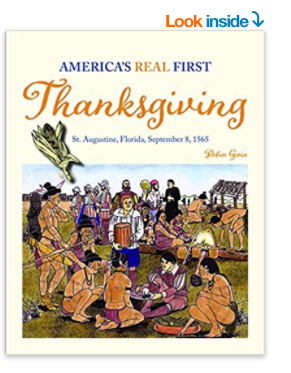Is it true that the Pilgrims had the first Thanksgiving in 1621 in Plymouth with the Wampanoags, as history tells us? Or, is there a different, untold side of the Thanksgiving tale? While the New England “first Thanksgiving” is well documented and a real thing that took place, it might not actually be the first time European colonists and Native Americans sat down to have a meal together. You have to remember; the Florida town of St. Augustine was founded by the Spanish empire more than fifty years before the Pilgrims ever landed at Plymouth.
There are historians who are questioning the status of the New England Thanksgiving as the first one in North America. Some believe the Spanish colonists in St. Augustine ate a celebrator meal at least once, and maybe more than once, with the Timucua tribe of Florida long before the Mayflower arrived on North American shores.
On September 8, 1565, Don Pedro Menendez de Aviles, a Spanish pioneer to North America, came ashore at the newly established colony of St. Augustine. The ship's priest, Father Francisco Lopez, held a cross up high for Aviles, who kissed it and then claimed the territory of Florida for God and Spain. While Aviles and the more than 800 colonists he brought with him were getting together for a Catholic mass of thanksgiving for their safe arrival and setting up a communal meal, there were curious Timucua looking on. Tradition states that Aviles invited the tribespeople to join them in that meal, and they accepted the invitation.
It is mainly historians in Florida, or who specialize in Florida history, who believe this is technically North America's first Thanksgiving, as the meal everyone shared was part of a religious ceremony of thanksgiving. After all, it was the first recorded European religious ceremony and Thanksgiving meal in North America (though, we don't know if the Vikings did anything similar when they colonized Nova Scotia five hundred years earlier).
There are a few Florida historians who have written books on the subject of the Spanish thanksgiving in St. Augustine. One such book, called “America's First Real Thanksgiving,” discusses the foods that were eaten at the Spanish thanksgiving meal, and how the differed from the ones served in Plymouth more than a half a century later. For example, the Spanish colonists had only just arrived in North America when they had their meal. They were therefore forced to eat food they brought over with them on the ship… essentially leftovers. This would have included hard biscuits and a garbanzo bean stew made with pork, cabbage, onions, and other vegetables and herbs that kept well for a long ocean voyage. They would have used red wine brought from Spain as their beverage with the meal.
In contrast, the Pilgrims had been in North America for nearly a year when they had their first Thanksgiving meal, which was to celebrate their first successful harvest. Up until that time, the local Wampanoag tribes had been teaching them how to survive in the harsh New England environment, including what to grow there for food, and how to cultivate it. As a result, the Pilgrims had fresh food for their meal of thanksgiving, as it was newly harvested from their beginning efforts at farming in this new land. This means the Pilgrim Thanksgiving would have included some foods that were native to North America, whereas the Spanish one included Spanish foods only, as those were all that were available when they set up that meal.
Of course, not everyone agrees even the St. Augustine Thanksgiving meal was the first official Thanksgiving in America. There are historians who argue that honor goes to the French Huguenots (essentially the French version of the Pilgrims) had a thanksgiving ceremony and meal a year earlier than the Spanish, in 1564 in what is now Jacksonville, but was then known as Fort Caroline. Like the Spanish, the French celebrated the establishment of their fort with a meal and a religious ceremony with the local Timucuans. There is an existing journal of a resident of Fort Caroline describing this celebration.
Of course, the French Huguenots didn't remain thankful at Fort Caroline for long. Only two weeks after landing at St. Augustine, Aviles led a band of soldiers on an assault on the fort and its residents, which killed 130 of the unfortunate Frenchmen and women. The Spanish, who were devoutly Catholic, saw the Huguenots as heretics. A few weeks after their assault on Fort Caroline, Aviles and his troops killed 200 French citizens who survived a shipwreck and washed up on shore near St. Augustine. In addition to being heretics, the Spanish also saw any French incursions in the Florida territory to be illegal interloping, as Spanish explorers discovered and laid claim to the land long before the French sent anyone over to look at it.
While the French and Spanish thanksgiving ceremonies and meals were largely forgotten by history until recently, they are now but two of several competing claims for the first official American Thanksgiving. It seems there are people who want to put the Pilgrims out of the Thanksgiving business. In Texas, for example, the Texas Society of the Daughters of the American Colonists recently put up a historical marker in Canyon, Texas, claiming Father Juan de Padilla performed a ceremony of thanksgiving there in May of 1541 to a 1,500-member army of conquistadors from Spain. There have also been claims from groups in Virginia and in Maine that their towns are the locations of the first real American Thanksgiving. Both Virginia and Maine did have European colonists before the Mayflower arrived… businessmen from England in Virginia and fur trappers from France in Maine… so it is theoretically possible that any of these places might have had the first genuine Thanksgiving in America.
In fact, it was common for explorers and colonists from Europe to have religious ceremonies for thanksgiving upon arriving on American shores… these ceremonies were to give thanks for a safe arrival. However, they were informal ceremonies that usually did not include a meal or Native Americans, and so cannot really be considered Thanksgiving ceremonies in the sense that we know the holiday today. The one celebrated in 1621 by the Pilgrims is still the one that most resembles a modern Thanksgiving.
These early, pre-Pilgrim thanksgiving ceremonies and meals also did not have a lasting impact on the traditions of this nation as the one held by the Pilgrims did. That one remained in the American imagination, and inspired the official national holiday that we celebrate today. Not even the Spanish celebration of Thanksgiving with the Timucua had a lasting impact on American traditions, nor did it hold a place in American cultural memory, as did the Pilgrim feast.
While any number of Thanksgiving celebrations can claim to be the “first” European on American shores, the fact that none of them influenced American culture and stayed in the American cultural memory like the celebration of the Pilgrims renders these other thanksgiving ceremonies and feasts moot to what we know today. There may have been other Thanksgivings, but, as far as American culture goes, there was only one first Thanksgiving, and that belongs to the Puritans.





